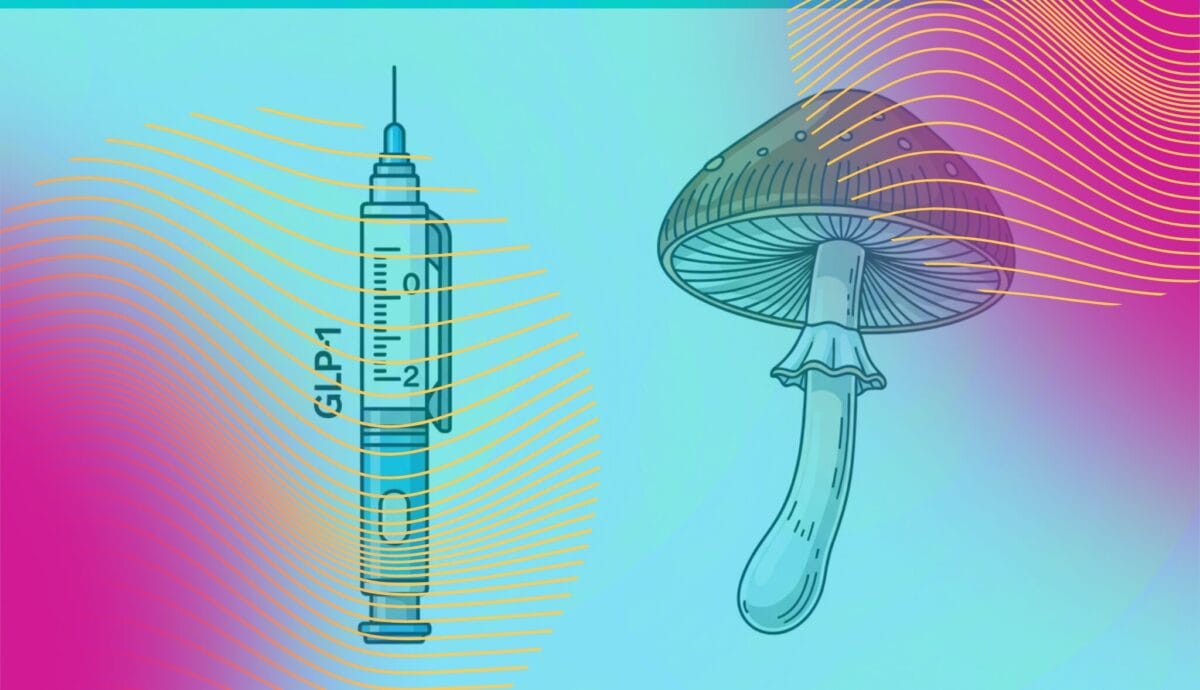More people than ever are taking GLP-1 receptor agonists—drugs like Ozempic (semaglutide), Wegovy, and Mounjaro. These medications, originally developed for type 2 diabetes, are now widely prescribed for weight loss. They work by mimicking the body’s natural GLP-1 hormone, which regulates blood sugar, slows stomach emptying, suppresses appetite, and alters gut motility.
This creates a digestive bottleneck. Food stays in the stomach longer. Movement through the intestines slows. Absorption becomes less predictable.
If you’re taking psilocybin mushrooms while on GLP-1 meds, this matters.
Psilocybin is a prodrug. It isn’t active in the body until converted into psilocin (4-HO-DMT). Psilocin is the compound that actually interacts with serotonin receptors. This conversion happens primarily in the gut and liver after oral ingestion. For most people, peak effects from mushrooms come 45 to 90 minutes after dosing.
GLP-1 agonists can slow down the process.
Some reports suggest that the interaction between GLP-1 drugs and psilocybin mushrooms can lead to:
- Delayed onset (2+ hours)
- Blunted or unpredictable effects
- Abrupt drop-offs instead of a gradual taper
- “Non-event” experiences where no noticeable effects occur
This is an important topic for several reasons, including control, safety, and proper expectation-setting. People are not getting the dose-response they expected and sometimes need to redose, or think they may be a non-responder.
A Community-Sourced Solution
In private Signal groups this week, a sharp observation emerged: what if you bypass the gut altogether?
One way to do that is through sublingual (under the tongue) or buccal (cheek pouch) administration of psilocin—the compound that psilocybin becomes after conversion. Psilocin is already active and can cross mucosal membranes into the bloodstream quickly, without requiring interaction with the stomach or intestines.
This method of delivery isn’t new. LSD, DMT, and ketamine lozenges can all be taken this way. It offers:
- Faster onset (often within 10–20 minutes)
- Higher bioavailability due to avoidance of first-pass liver metabolism
- Less dose variability, since absorption doesn’t rely on digestion
- Greater consistency, especially for people with GI disorders or those on meds that slow digestion
In the context of GLP-1 users, this could restore reliable access to psychedelic states that mushrooms alone might not deliver.t
Pharmacokinetics 101
To understand the benefit here, consider the basics of how psilocybin works in the body:
- After oral ingestion, psilocybin is dephosphorylated into psilocin in the liver and gut, primarily via alkaline phosphatase.
- Psilocin then binds to 5-HT2A receptors in the brain, initiating the psychedelic experience.
- Sublingual administration of psilocin skips the enzymatic conversion stage and enters systemic circulation more directly.
- Oral psilocybin undergoes first-pass metabolism, which can vary significantly between individuals and can be altered by drugs such as GLP-1 agonists.
This metabolic detour—via the mouth, rather than the gut—could make a significant difference.
Stability and Access
There are tradeoffs. Psilocin is more chemically unstable than psilocybin and more prone to oxidation. It requires careful formulation, often in a stabilized liquid or film. It’s also more tightly scheduled in many jurisdictions.
But these challenges aren’t insurmountable.
Pharmaceutical startups, underground chemists, and harm reduction collectives are already exploring stable psilocin preparations, including nasal sprays, tinctures, injections, and lozenges. The sublingual route may become increasingly relevant as more people navigate the intersection of psychedelics and modern medicine.
Why This Matters
Psychedelic therapy is maturing, but our assumptions about preparation and dosing still lag behind. As we move toward increases in regulated access and inclusive models of care, we need to continue deepening our understanding of how common medications—SSRIs, benzos, and now GLP-1 drugs—affect psychedelic experiences.
We also need to keep space for community insight. This workaround—raised quietly by anonymous voices in encrypted chat groups—is a good example.
No need for a white paper.
The logic is clear.
The implications are important.
Final Thoughts
If you’re working with clients who are using GLP-1 agonists and planning to take mushrooms, be cautious. Test doses may underperform. Delayed peaks can confuse expectations and schedules. Stronger-than-expected effects can hit suddenly hours later.
This is an area that is ripe for further study.
In the meantime, sublingual psilocin offers a compelling alternative, rooted in pharmacology, supported by anecdote, and increasingly accessible.
We’re in new territory. Let’s learn together.



